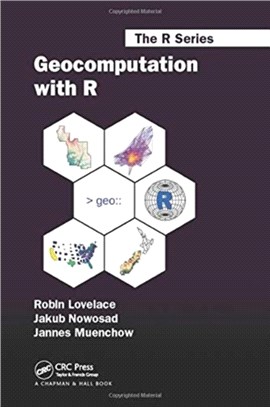Geocomputation with R
商品資訊
ISBN13:9780367670573
出版社:PBKTYFRL
作者:Robin (University of Leeds Lovelace UK); Jakub (Adam Mickiewicz University Poznan Nowosad Poland); Jannes (Friedrich Schiller University Muenchow Jena Germany)
出版日:2020/12/18
裝訂/頁數:平裝/335頁
規格:15.6cm*23.5cm (高/寬)
定價
:NT$ 2759 元優惠價
:90 折 2483 元
無庫存,下單後進貨(到貨天數約45-60天)
下單可得紅利積點:74 點
商品簡介
相關商品
商品簡介
Geocomputation with R is for people who want to analyze, visualize and model geographic data with open source software. It is based on R, a statistical programming language that has powerful data processing, visualization, and geospatial capabilities. The book equips you with the knowledge and skills to tackle a wide range of issues manifested in geographic data, including those with scientific, societal, and environmental implications.
This book will interest people from many backgrounds, especially Geographic Information Systems (GIS) users interested in applying their domain-specific knowledge in a powerful open source language for data science, and R users interested in extending their skills to handle spatial data. The book is divided into three parts: (I) Foundations, aimed at getting you up-to-speed with geographic data in R, (II) extensions, which covers advanced techniques, and (III) applications to real-world problems. The chapters cover progressively more advanced topics, with early chapters providing strong foundations on which the later chapters build.
Part I describes the nature of spatial datasets in R and methods for manipulating them. It also covers geographic data import/export and transforming coordinate reference systems. Part II represents methods that build on these foundations.
It covers advanced map making (including web mapping), "bridges" to GIS, sharing reproducible code, and how to do cross-validation in the presence of spatial autocorrelation. Part III applies the knowledge gained to tackle real-world problems, including representing and modeling transport systems, finding optimal locations for stores or services, and ecological modeling. Exercises at the end of each chapter give you the skills needed to tackle a range of geospatial problems.
Solutions for each chapter and supplementary materials providing extended examples are available at https://geocompr.github.io/geocompkg/articles/. Dr. Robin Lovelace is a University Academic Fellow at the University of Leeds, where he has taught R for geographic research over many years, with a focus on transport systems.
Dr. Jakub Nowosad is an Assistant Professor in the Department of Geoinformation at the Adam Mickiewicz University in Poznan, where his focus is on the analysis of large datasets to understand environmental processes. Dr.
Jannes Muenchow is a Postdoctoral Researcher in the GIScience Department at the University of Jena, where he develops and teaches a range of geographic methods, with a focus on ecological modeling, statistical geocomputing, and predictive mapping. All three are active developers and work on a number of R packages, including stplanr, sabre, and RQGIS.
This book will interest people from many backgrounds, especially Geographic Information Systems (GIS) users interested in applying their domain-specific knowledge in a powerful open source language for data science, and R users interested in extending their skills to handle spatial data. The book is divided into three parts: (I) Foundations, aimed at getting you up-to-speed with geographic data in R, (II) extensions, which covers advanced techniques, and (III) applications to real-world problems. The chapters cover progressively more advanced topics, with early chapters providing strong foundations on which the later chapters build.
Part I describes the nature of spatial datasets in R and methods for manipulating them. It also covers geographic data import/export and transforming coordinate reference systems. Part II represents methods that build on these foundations.
It covers advanced map making (including web mapping), "bridges" to GIS, sharing reproducible code, and how to do cross-validation in the presence of spatial autocorrelation. Part III applies the knowledge gained to tackle real-world problems, including representing and modeling transport systems, finding optimal locations for stores or services, and ecological modeling. Exercises at the end of each chapter give you the skills needed to tackle a range of geospatial problems.
Solutions for each chapter and supplementary materials providing extended examples are available at https://geocompr.github.io/geocompkg/articles/. Dr. Robin Lovelace is a University Academic Fellow at the University of Leeds, where he has taught R for geographic research over many years, with a focus on transport systems.
Dr. Jakub Nowosad is an Assistant Professor in the Department of Geoinformation at the Adam Mickiewicz University in Poznan, where his focus is on the analysis of large datasets to understand environmental processes. Dr.
Jannes Muenchow is a Postdoctoral Researcher in the GIScience Department at the University of Jena, where he develops and teaches a range of geographic methods, with a focus on ecological modeling, statistical geocomputing, and predictive mapping. All three are active developers and work on a number of R packages, including stplanr, sabre, and RQGIS.
主題書展
更多
主題書展
更多書展今日66折
您曾經瀏覽過的商品
購物須知
外文書商品之書封,為出版社提供之樣本。實際出貨商品,以出版社所提供之現有版本為主。部份書籍,因出版社供應狀況特殊,匯率將依實際狀況做調整。
無庫存之商品,在您完成訂單程序之後,將以空運的方式為你下單調貨。為了縮短等待的時間,建議您將外文書與其他商品分開下單,以獲得最快的取貨速度,平均調貨時間為1~2個月。
為了保護您的權益,「三民網路書店」提供會員七日商品鑑賞期(收到商品為起始日)。
若要辦理退貨,請在商品鑑賞期內寄回,且商品必須是全新狀態與完整包裝(商品、附件、發票、隨貨贈品等)否則恕不接受退貨。
























